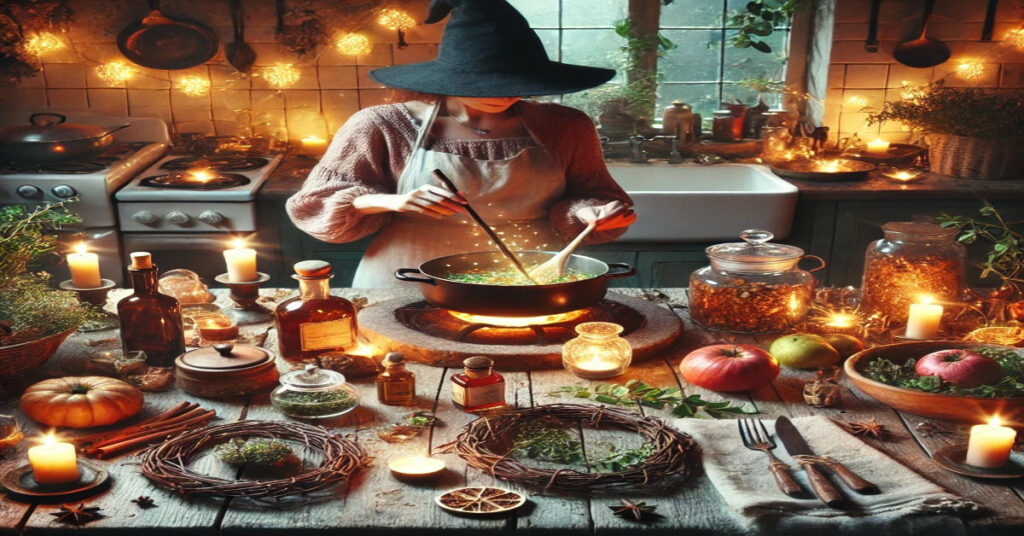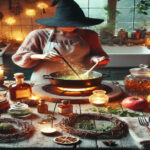There’s something enchanting about the kitchen. For many of us, it’s not just a place where we prepare meals—it’s where family traditions are born, where flavors tell stories, and where ingredients hold secret powers. One of the most fascinating traditions that embrace this kind of everyday magic is the practice of being a kitchen witch. This concept brings together food, magic, and intuition to create a harmonious blend of nourishment and mysticism.
In this article, we’ll explore the art of the kitchen witch—what it is, its origins, the tools it involves, and how you can incorporate this ancient practice into your daily life. So, if you’ve ever wondered how food and magic can intertwine, this guide is for you.
What Is a Kitchen Witch?
A kitchen witch is someone who practices a form of witchcraft that focuses on food, herbs and everyday tasks in the kitchen to bring about magical results. It’s a practice grounded in the belief that the act of cooking can have spiritual significance. The kitchen witch believes that the energy, intention, and care put into meals can have a profound effect on both the cook and those who partake in the meal.
Being a kitchen witch doesn’t require elaborate rituals or spells—it’s about bringing love, intention, and mindfulness into the act of cooking. Whether you’re baking bread, stirring a pot of soup, or making tea, you can infuse those tasks with magical energy.
The History and Origins of the Kitchen Witch
The kitchen witch tradition is rooted in old European folk practices. Historically, women—especially grandmothers and mothers—were the keepers of household knowledge. They were the ones who knew how to cook hearty meals from scratch, preserve food, and use herbs for healing. Over time, these practical skills became intertwined with spiritual beliefs and rituals.
In the past, kitchens were often seen as sacred spaces where the practical and the magical coexisted. The hearth was the heart of the home, where warmth and sustenance came from. It’s no surprise then that witches who practiced in this space were often viewed as healers and caretakers, working with nature’s ingredients to nourish both the body and the soul.
Kitchen witchery also connects to pagan traditions, particularly those involving the cycles of the seasons. The kitchen witch recognizes the magic in the natural world—be it the changing of seasons, the growth of herbs, or the energy of the full moon—and uses this awareness in her daily cooking rituals.
The Tools and Ingredients of a Kitchen Witch
Unlike other forms of witchcraft, which might require special tools like wands, cauldrons, or altars, kitchen witchery relies on everyday items that can be found in any well-stocked kitchen. From pots and pans to wooden spoons and measuring cups, the tools of the kitchen witch are all part of the ritual.
Here are a few essential tools and ingredients you’ll find in the kitchen witch’s arsenal:
- Herbs and Spices: The backbone of kitchen witchery, herbs and spices aren’t just for flavor—they carry their own magical properties. For example, basil is thought to promote love and good fortune, while rosemary is known for its protective qualities.
- Cast Iron Cookware: Cast iron is known for its ability to hold and transfer energy. Many kitchen witches favor using cast iron skillets and pots because they can absorb the cook’s energy and intentions during food preparation.
- Wooden Utensils: Wood is a grounded, natural material. Kitchen witches often prefer using wooden spoons, rolling pins, and cutting boards as they’re believed to carry a connection to the earth and the elements.
- Jars and Bottles: These are used to store herbs, oils, teas, and magical potions. They can be adorned with sigils or other magical symbols to enhance their effectiveness.
- Candlelight: Candles, especially those in colors corresponding to specific intentions (like green for prosperity or white for purity), are often used in kitchen witch rituals to set the mood and focus intentions.
- Crystals: Crystals are often placed around the kitchen for their ability to balance energies. Amethyst for calm, citrine for creativity, or rose quartz for love might find a home in the kitchen to promote certain energies during meal prep.
Magical Intentions: How Kitchen Witchery Works
The core of kitchen witchcraft is intention. While many witches perform elaborate rituals to cast spells or perform magic, kitchen witches believe that cooking itself is a form of magic. By imbuing food with intention, the cook can influence the energy that the food carries, whether it’s for healing, protection, or attracting love.
For example, when preparing a meal for a loved one, a kitchen witch may infuse the food with positive energy, focusing on feelings of love and warmth. Alternatively, when cooking for protection, she might stir in intentions for safety and well-being. Even something as simple as baking bread can become a ritual of manifestation if the witch puts her energy and thoughts into it.
Here’s a simple example: making a cup of tea. If a kitchen witch is preparing tea for clarity, she might choose herbs like peppermint (for mental clarity) or lemon balm (for calmness). As she brews the tea, she would focus on her intention, possibly repeating a mantra or saying a blessing over the cup. When the tea is ready, it’s not just a drink—it’s a potion charged with the witch’s energy and intention.
Kitchen Witch and Herbal Magic: The Power of Plants
One of the most powerful aspects of kitchen witchery is the use of herbs. Herbs are magical in many ways—not only do they enhance the flavor of food, but they are also associated with different properties and powers. Here’s a glimpse into some common herbs used in kitchen witchcraft:
- Basil: This herb is often used for good luck and prosperity. It’s great for adding positive energy to meals and is considered a protective herb.
- Rosemary: Known for its protective properties, rosemary is also said to improve memory and is often used to clear negative energy from a space.
- Thyme: This herb is said to promote courage and strength, and it can be used in dishes meant to boost resilience or help someone overcome challenges.
- Lavender: Lavender is often used for calming, peaceful energy. It’s perfect for creating a serene atmosphere in the kitchen or for preparing relaxing meals.
- Sage: Often used in cleansing rituals, sage can also be used in cooking to purify the energy of a space and protect the cook from negativity.
Creating Rituals in the Kitchen
For kitchen witches, meal preparation can become a form of ritual. Whether it’s a special holiday feast or an everyday dinner, the act of cooking is sacred. Here are a few examples of simple kitchen witch rituals you can incorporate into your daily life:
- Blessing the Ingredients: Before beginning to cook, take a moment to bless the ingredients you’re using. Hold them in your hands and say a few words of gratitude, focusing on the intention behind your meal. This could be a prayer for nourishment, healing, or protection.
- Stirring with Intention: When stirring a pot, visualize your desired outcome. If you’re making a soup for a loved one, imagine it filling them with warmth and love. Stir clockwise for positive outcomes, and counterclockwise to remove negativity.
- Setting a Magical Table: When you set the table for a meal, arrange your plates and utensils with intention. You can place candles, crystals, or herbs on the table to enhance the energy. This helps set the mood and align the meal with your magical purpose.
The Benefits of Being a Kitchen Witch
Embracing kitchen witchery can bring many benefits into your life. It fosters a deeper connection to food, tradition, and the Earth. Here are some of the advantages of becoming a kitchen witch:
- Mindfulness and Presence: By focusing on the process of cooking and infusing it with intention, you cultivate mindfulness, reducing stress and creating a peaceful, focused atmosphere in your kitchen.
- Healing Through Food: As a kitchen witch, you can use food as a tool for healing, whether that’s physical, emotional, or spiritual. Herbs and spices are known to have therapeutic effects, and preparing food with care and intention can elevate its healing properties.
- Building Tradition: Many kitchen witches are also caretakers of family recipes and traditions. Being a kitchen witch can help keep these customs alive, passing them down through generations with the added magic of intention and love.
Conclusion
Being a kitchen witch is all about recognizing the magic that exists in the everyday. It’s about finding spirituality in simple tasks, like chopping vegetables or stirring a pot. By infusing your cooking with intention, you not only nourish your body but also your soul, creating a magical atmosphere that enhances every meal.
If you’ve been looking for a way to bring more mindfulness, magic, and love into your life, embracing kitchen witchery may be the perfect practice for you. Whether you’re cooking a simple meal or preparing a holiday feast, the energy and intention you put into your food can create a lasting impact on those who share it with you.
FAQs
- What is a kitchen witch?
A kitchen witch is someone who practices witchcraft through cooking, using food, herbs, and everyday kitchen tasks to create magical energy. - Do I need special tools to be a kitchen witch?
No, being a kitchen witch only requires everyday kitchen items, like herbs, utensils, and intention, to practice your magic. - Is kitchen witchery related to traditional witchcraft?
Yes, kitchen witchery is a form of folk witchcraft, often blending practical cooking skills with magical practices. - Can anyone become a kitchen witch?
Absolutely! Anyone can embrace the practice of kitchen witchery, regardless of experience or background in witchcraft. - What kind of spells can kitchen witches do?
Kitchen witches often work with food, herbs, and potions to create spells for love, protection, health, and prosperity, all through the energy they infuse into their cooking.







